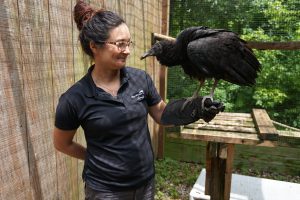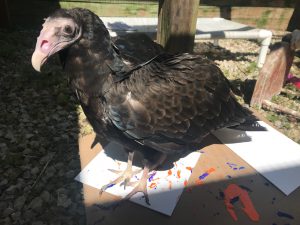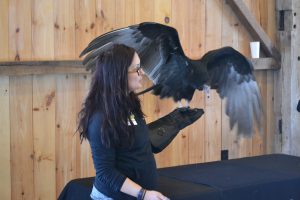
Two vultures have joined the Animal Ambassador team at Ohio Wildlife Center, helping to expand people’s awareness about these often misunderstood scavenger birds built for their unique role in the ecosystem.
A Black Vulture named Ranger and a Turkey Vulture named Chase each arrived at the Education Center through different paths, but they now share opportunities to give visitors a unique view of nature’s recyclers. Chase has significant vision problems, which is a serious condition for a species that relies on superior sight to locate food. His training to join the education team has been tailored for this issue with verbal cues used instead of sight cues, according to Stormy Gibson, director of education and Chase’s primary handler.
Chase was brought to the Wildlife Center from Athens last fall, delivered in a pick-up truck by a Hocking Technical College student. The fledgling vulture had been found on private property, orphaned due to its medical issues when the family likely moved on, Gibson said. The property owners contacted Ohio Wildlife Center about the vulture and it was transferred to the Wildlife Hospital.
At its medical evaluation, Chase’s vision issues were diagnosed, with cataracts contributing to his diminished sight. It was then the Center applied for a permit from the Division of Wildlife to keep Chase as an Animal Ambassador. Because of his young age and social nature, Gibson began training the vulture with extensive verbal cues and reinforcement.
“Chase is an excellent Animal Ambassador for visitors to be able to not only learn about vultures, but experience them up close, something that rarely happens in the wild because of the remote locations where vultures nest and roost,” Gibson said.

Ranger also made his way to the Wildlife Center via a pick-up truck. Last June, an unsuspecting man found a softball-sized chick in the back of his parked truck. It was an unusual find, Gibson noted, as Black Vultures typically lay their eggs in dark, sheltered areas such as tree cavities, tree stumps, hollow logs, caves and abandoned buildings.
There was no obvious nesting around the truck to suggest any vulture parents had chosen the unusual location and there were no distressed adult birds in sight trying to make contact with a defenseless chick.
“Black Vultures are excellent caregivers,” Gibson said. “Birds that feed their fledglings for eight months and then accompany them on at least two migrations would never abandon, lose or leave them unattended.” She ventures that a thieving bird might have been the culprit, one that misjudged the chick’s weight and dropped it along the way.
“An eventual release was always the goal,” Gibson explained. “So my first priority was to find him a companion, either an adult to act as a foster or a chick to keep him company.”
Hoping she could place him in another vulture’s nest, she reached out to the birding community in search of active nesting sites, but the chicks they identified were too big. Other rehabilitation centers could not help, as their Black Vultures were too old to pair with Ranger.
“Black Vultures are affable creatures and Ranger was initially segregated to prevent imprinting,” Gibson said. Without a fostering environment with another vulture family he could not likely be released, so it was in the bird’s best interest to provide an enriched environment, she said. OWC applied for and was granted a permit to keep Ranger as an Animal Ambassador. He currently resides in the Dempsey animal building at the Center, where visitors can glimpse up-close the unique anatomy that vultures use to their advantage.
As the primary consumers of carrion – the remains of other dead animals – vultures should be viewed as an environmental HAZMAT crew, Gibson said, as they actually help curb the spread of disease. They also eat the animal parts that other foragers won’t touch.
Their beaks are made for tearing flesh and they are bald as they often place their heads inside a carcass, making a feathered head impractical. Their digestive systems are made to protect them from the bacteria they encounter in the decayed food that is their main diet. They will also defend themselves by vomiting on predators to chase them away.

According to Gibson, Black Vultures and Turkey Vultures are often seen together in the wild, with Turkey Vultures featuring a red head and dark feathers that include brown. Black Vultures, with a sense of smell far inferior to the Turkey Vulture, will often follow Turkey Vultures to food and soar above them as they detect the scent of a carcass. It is their smell, not sight, that helps them find food, Gibson noted, but their vision enables them to see a carcass well enough to land. When the Turkey Vulture descends, the Black Vulture is often close behind.
While both Turkey and Black Vultures roost in large colonies, Black Vultures are devoted family members and mate for life. Their strength in numbers often give Black Vultures the advantage at shared meals, with the larger Turkey Vultures losing out to a flock of more aggressive scavengers.
For now, Chase and Ranger have separate accommodations at the Wildlife Center, as Ranger’s vision problems require a more protected enclosure. Gibson hopes to provide a shared space in the future if Chase’s sight improves.
“We are excited to have Chase and Ranger with us to help educate the public about vultures and their place in nature,” Gibson said. “They bring a new perspective to how efficiently the environment is stewarded through these special birds.”
Author and volunteer Linda Forte-Spearing contributed to this article.